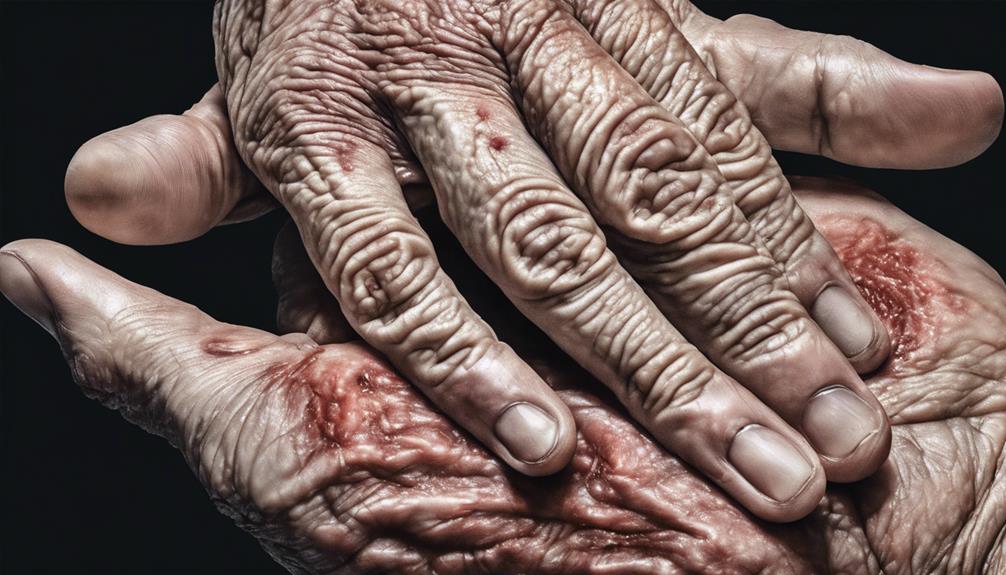Early signs of Parkinson’s disease can present through symptoms such as tremors in the hands, arms, legs, and jaw. These tremors are typically involuntary and can vary in intensity. Muscle stiffness and rigidity can affect movement and flexibility, often resulting in muscle cramps. Bradykinesia, which is slowness of movement, can make simple tasks more difficult. Impaired balance and coordination may lead to challenges with walking. Emotional changes, mood swings, difficulty swallowing, and skin issues like excessive sweating are also common symptoms to be aware of. Recognizing these signs early on can assist in effectively managing the condition.
Key Takeaways
- Tremors in hands, arms, and legs at rest.
- Muscle stiffness and rigidity affecting movement.
- Slowness of movement (Bradykinesia) in daily tasks.
- Impaired balance and coordination leading to walking difficulties.
- Emotional changes and mood disorders like depression.
Tremors in Hands, Arms, Legs, Jaw
When experiencing the early signs of Parkinson's disease, one may notice tremors in their hands, arms, legs, and jaw as involuntary shaking or twitching movements. These tremors can vary in intensity and frequency, affecting daily activities such as writing or eating. It's important to understand that these tremors often occur at rest and may improve with purposeful movement, which is a distinctive feature of Parkinson's disease.
Managing tremors in Parkinson's involves a combination of strategies aimed at improving quality of life. Medications prescribed by healthcare providers can help control tremors and other symptoms associated with the condition. Additionally, physical therapy plays a vital role in enhancing motor skills and reducing the impact of tremors on daily functioning. Lifestyle modifications, such as stress management techniques and regular exercise, can also contribute to minimizing tremors and improving overall well-being. By implementing these management strategies, individuals with Parkinson's can better cope with tremors and lead more fulfilling lives.
Muscle Stiffness and Rigidity

As we explore further into the progression of Parkinson's disease, muscle stiffness and rigidity emerge as prominent early indicators, impacting movement and flexibility. Stiffness in muscles can make it challenging to start movements, hindering daily tasks.
On the other hand, rigidity can lead to muscle cramps, pain, and a reduced range of motion. These symptoms result from the loss of dopamine-producing nerve cells in the brain, which play a vital role in regulating movement.
To manage muscle stiffness and rigidity, various strategies can be employed. These may include engaging in physical therapy to improve flexibility and mobility, taking medications prescribed by healthcare providers to address the underlying issues, and making lifestyle adjustments to enhance overall quality of life.
Slowness of Movement (Bradykinesia)
Bradykinesia, a hallmark sign of Parkinson's disease, causes a noticeable slowness in movements. It can make tasks like walking or dressing more challenging due to the difficulty in initiating actions.
This symptom stems from neurological issues rather than muscle weakness, affecting the body's ability to control movement.
Muscle Stiffness and Rigidity
Muscle stiffness and rigidity in Parkinson's disease often result in difficulty moving due to increased muscle tone and inflexibility. Rigidity can affect the arms, legs, and trunk, leading to stiffness in the muscles.
Bradykinesia, or slowness of movement, is a common symptom of Parkinson's, making simple tasks like walking or standing up challenging. Patients may feel heaviness in their limbs due to these symptoms. These issues can impact daily activities, contributing to the characteristic slow movements associated with Parkinson's disease.
It's essential to address these symptoms early on to provide the best care and support for individuals experiencing muscle stiffness, rigidity, and bradykinesia in Parkinson's disease.
Difficulty With Fine Movements
Moving with precision and ease becomes challenging as Parkinson's disease progresses, particularly in tasks requiring fine movements. Bradykinesia, a hallmark symptom of Parkinson's, manifests as stiffness and slow movements, making daily activities like buttoning a shirt or writing with a pen difficult.
This slowness isn't due to muscle weakness but arises from impaired communication between the brain and muscles. Individuals with bradykinesia may struggle to initiate movements and experience a limited range of motion. Treatment often involves medications that boost dopamine levels in the brain to alleviate these symptoms.
If you notice yourself or a loved one having trouble with delicate tasks or feeling slower in movements, seeking medical advice promptly can help manage these challenges effectively.
Impaired Balance and Coordination

Experiencing impaired balance and coordination is a significant indicator of the progression of Parkinson's disease. Balance issues can result in difficulties with walking, increased risk of falls, and challenges in performing tasks that require coordination. Coordination problems may present as a shuffling gait, trouble turning, or struggles with fine motor skills like buttoning clothes.
Individuals with Parkinson's disease may find it hard to maintain stability while standing, sitting, or moving around, making daily activities like climbing stairs a challenging task. Addressing these balance and coordination issues early on is essential. Physical therapy, along with medication management, can play a crucial role in improving these symptoms and enhancing the quality of life for those living with Parkinson's disease.
If you or a loved one are experiencing balance issues or coordination problems, it's essential to seek guidance from healthcare professionals promptly. By taking proactive steps such as engaging in physical therapy, individuals can better manage these symptoms and maintain their independence for longer periods.
Emotional Changes and Mood Disorders

Emotional changes in Parkinson's disease, like mood swings and depression, can impact our daily lives considerably. These fluctuations are often due to alterations in dopamine levels, a chemical messenger in the brain.
Managing these mood disorders may involve a combination of medication, therapy, and support from healthcare professionals.
Mood Swings and Parkinsons
In Parkinson's disease, mood swings and emotional changes impact up to 40% of individuals with the condition. These fluctuations can manifest as feelings of depression, anxiety, irritability, and apathy, affecting both the individual's quality of life and their relationships.
The shifts in mood are often linked to changes in brain chemistry, particularly in areas responsible for processing emotions that are affected by Parkinson's. Fortunately, mood disorders in Parkinson's can be managed with medications, therapy, and adjustments to one's lifestyle to enhance emotional well-being.
Seeking support from healthcare professionals and loved ones is essential for effectively addressing these mood changes and improving overall mental health. Remember, you aren't alone in this journey, and help is available to assist you in overcoming these emotional challenges.
Emotional Instability in PD
Emotions can become unpredictable and challenging to manage for individuals with Parkinson's disease, often leading to mood disorders such as depression and anxiety. Changes in mood and emotional regulation can have a major impact on the quality of life for those with Parkinson's. This emotional instability may stem from chemical changes in the brain as the disease progresses. Symptoms like irritability, apathy, and emotional outbursts may arise.
Managing emotional instability in Parkinson's typically involves a combination of medication, therapy, and support from healthcare professionals. It's important to seek help and support to address these mood disorders and enhance emotional well-being. Understanding these challenges can aid in handling the emotional aspects of Parkinson's disease effectively.
Difficulty Swallowing (Dysphagia)

Experiencing difficulty swallowing, a common symptom in Parkinson's disease, can impact an individual's ability to consume food safely and efficiently. Dysphagia, as it is known, can lead to choking, aspiration, and a higher risk of malnutrition among those with Parkinson's. Speech-language pathologists are essential professionals who specialize in treating swallowing difficulties. They provide swallowing therapy to address dysphagia, helping to prevent complications related to swallowing challenges. By changing food textures or types, dysphagia in Parkinson's patients can be managed effectively, improving their ability to swallow safely. Additionally, managing embarrassing issues like drooling can also be part of addressing dysphagia in individuals with Parkinson's disease. Utilizing the expertise of speech-language pathologists can significantly enhance the quality of life for those facing swallowing difficulties.
| Benefits of Speech-Language Pathologists | ||
|---|---|---|
| Provide swallowing therapy to address dysphagia | Help prevent complications related to swallowing difficulties | Enhance the quality of life for individuals with Parkinson's |
Skin Problems and Changes

Skin issues like excessive sweating, oily skin, and seborrheic dermatitis are common problems experienced by individuals with Parkinson's disease. Changes in skin texture, such as dryness, redness, or acne, can also occur.
Medications used to manage Parkinson's symptoms may contribute to skin problems like rashes or hypersensitivity reactions. Additionally, reduced skin elasticity and collagen production in Parkinson's patients can lead to wrinkles and sagging.
These skin problems can impact quality of life and may require dermatological management alongside Parkinson's treatment. It's important to pay attention to any skin changes and seek advice from healthcare providers to address them effectively.
Proper skincare routines and consultation with dermatologists can help manage these issues and improve overall skin health. By being proactive and seeking appropriate care, individuals with Parkinson's disease can better manage skin problems and maintain their well-being.
Frequently Asked Questions
What Is Usually the First Symptom of Parkinson Disease?
Resting tremor is often the first symptom of Parkinson's disease, starting on one side of the body. It can affect hands, arms, legs, jaw, or head. Early detection is important for managing symptoms effectively.
How Long Can You Have Parkinson's Without Knowing?
Unbeknownst to us, we could unknowingly harbor Parkinson's for years. Missing the signs, we chug along, unaware. Seeking timely care is essential. Let's not play hide and seek with our health.
What Are the Four Cardinal Signs of Parkinson's Disease?
Recognizing the four cardinal signs of Parkinson's disease is vital: tremor, rigidity, bradykinesia, and postural instability. These symptoms include persistent twitching, muscle stiffness, slowness of movement, and impaired balance. Identifying these signs early is essential for timely intervention and management.
What Is Stage 1 of Parkinson's Disease?
Stage 1 of Parkinson's disease is the initial phase characterized by mild symptoms affecting one side of the body. These symptoms, such as mild tremors and changes in posture, can be managed to slow down disease progression.
Conclusion
To sum up, identifying the early signs of Parkinson's disease is essential for prompt diagnosis and treatment. Like a compass pointing north, these symptoms can lead you towards seeking medical help and managing the condition effectively. By paying attention to these subtle cues, individuals can take proactive steps in addressing their health concerns before the condition progresses. Similarly, recognizing the **first signs of Lewy body dementia**—which may overlap with Parkinson’s symptoms, such as impaired movement and cognitive difficulties—can aid in early intervention and treatment. Early detection in both conditions can significantly improve the quality of life for those affected.
Remember, early detection can significantly enhance quality of life and slow down the progression of the disease. Stay informed, stay vigilant, and take action if you notice any of these warning signs.









